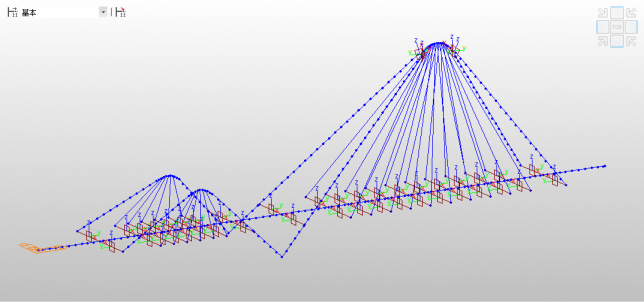论文总字数:58833字
摘 要
本文首先简要介绍了钢拱桥的结构特点与发展现状,然后介绍了拱梁组合体系桥的特点与施工方法。以大同市北环路御河桥主桥为例,进行成桥阶段和施工阶段的模拟计算分析。大同市北环路御河桥主桥为四跨一联连续拱梁协作体系,主跨采用连续空间三角形拱桥,为钢梁钢拱结构,拱梁固结结构体系。
首先,简要介绍了工程设计背景、工程概况及建设条件、主要技术标准、桥梁总体布置和方案比选。其中方案比选包括主桥桥型方案比选、结构体系方案比选和主梁形式方案比选。
利用桥梁有限元分析软件Midas civil 2012进行主桥的有限元建模,选择合适的材料、截面、单元类型、边界条件与荷载模型。荷载模型根据规范考虑自重、二期恒载、拉索预加力、汽车荷载、人群荷载、温度作用和支座沉降,并采用容许应力法进行荷载标准值组合。接着进行索力优化,确定成桥状态的合理索力。
主桥建模完成后,进行每种荷载组合下主桥成桥状态的静力分析,包括主梁、拱肋和拉索的内力与应力分析,然后进行应力验算,并简要进行主桥的动力特性分析。
然后进行主桥成桥阶段的刚度及稳定性验算,包括主梁的刚度验算、疲劳验算及拱肋的刚度验算。采用Midas软件的屈曲分析功能进行主桥的整体稳定性验算,根据规范的构造要求考虑构件的局部稳定性验算。
下一步进行主桥施工阶段的分析。重点考虑张拉拉索到指定索力时的主桥施工阶段模型,验算主梁、拱肋和拉索的内力与应力是否在允许范围内。
最后,由于所有拉索都直接锚固在拱顶,造成拱顶的局部应力过大,所以要通过在拱顶处焊接一对连接板来分担索力。首先确定主、副拱拱顶连接板的尺寸,然后利用大型通用有限元分析软件Ansys进行拱顶拉索连接板的局部应力分析,并进行主应力验算。
关键词:钢拱桥;有限元分析;钢桥设计;三角形拱
Abstract
First, this article briefly introduces the structural feature and development status of steel arch bridge, then this article introduces the characteristics and construction methods of the bridge of collaboration system of continuous arch and beam. Take the main bridge of Datong Beihuan Road Yuhe Bridge as an example, calculation and analysis of the final stage and the construction stage has been done. The main bridge of Datong Beihuan Road Yuhe Bridge is a collaboration system of continuous arch and beam which has four spans. The main span is continuous space triangle arch bridge. The structure has steel beam and steel arch, and the structure system is that arch and beam are consolidated with each other.
First of all, the background of the project, the overview of the project and the construction conditions, the main technical standards, the general arrangement of the bridge and the alternatives are briefly introduced. The alternatives include comparison of the main bridge type scheme, comparison of the structural system and comparison of the form of the main beam.
Use bridge finite element analysis software Midas civil 2012 to build the finite element model of the main bridge. Choose the suitable material, cross section, unit type, boundary conditions and load models. According to the specification, the weight of the load model, second dead load, booms pre stressed, vehicle load, the crowd load, temperature effects and support settlements are considered in the load model, then do load standard value combination using allowable stress method. After that, optimized boom forces are considered to determine the reasonable boom forces in the status of the final stage.
After the modeling of the main bridge is completed, do the static analysis of the main bridge under the load combination, including analysis of the internal force and stress of the main beam, arch rib and boom. Then check the stress, and briefly analyze the dynamic characteristics of the bridge.
Then do the stiffness and stability checking of the main bridge, including stiffness checking and fatigue checking of the main beam, and rigidity checking of the arch rib. Use the buckling analysis function of Midas software to check the overall stability of the main bridge. Consider the local stability checking according to the specification of the structural requirements.
The next step is to analyze the construction stage of the main bridge. Take key considerations of the model of the main bridge construction stage when the booms are tensed to specified cable force, and check whether the internal force and stress of the main beam, rib and boom is within the allowable range.
Finally, since all booms are anchored directly to the dome, which can result in large local stress in the dome. The way to solve this problem is to weld a pair of connecting plate to the dome, which can share the tensile force. First the size of the connecting plate in the primary and secondary arch vault should be determined, then use the general finite element analysis software Ansys to analyze the stress of the vault cable connecting plate. Finally check the principal stress.
Key words: Steel arch bridge; Finite element analysis; Design of steel bridge; Triangle arch
目录
摘要 1
Abstract 2
第一章 绪论 7
1.1 钢拱桥概述 7
1.2 拱梁组合体系桥的特点与施工 7
1.3 有限元分析基本理论 8
1.4 工程设计背景 9
1.5 本文主要内容 10
第二章 大同市御河桥工程介绍 12
2.1 工程概况及建设条件 12
2.2 主要技术标准 12
2.3 桥梁总体布置 13
2.4 方案比选 15
2.4.1 主桥桥型方案比选 15
2.4.2 结构体系方案比选 15
2.4.3 主梁形式方案比选 16
第三章 主桥有限元建模 17
3.1 空间三角拱形斜拉桥设计计算流程 17
3.2 计算模型概况 18
3.3 材料、单元与截面 19
3.4 边界条件 21
3.5 作用与作用效应组合 23
3.5.1 永久作用 23
3.5.2 可变作用 25
3.5.3 作用组合 27
第四章 成桥状态合理索力的确定 28
4.1 空间三角拱形斜拉桥合理成桥状态的确定 28
4.2 索力优化理论与方法 29
4.3 索力优化方案 30
4.4 索力优化方案比选 31
4.5 索力优化结果验算 34
4.5.1 主梁和拱肋变形验算 34
4.5.2 拉索强度验算 35
4.6 索力优化结果调整 35
第五章 成桥状态受力分析与应力验算 37
5.1 容许应力法基本理论 37
5.2 主梁分析 38
5.2.1 主梁关键截面内力影响线 38
5.2.2 主梁内力 41
5.2.3 主梁应力 44
5.2.4 主梁应力验算 48
5.3 拱肋分析 49
5.3.1 拱肋内力 49
5.3.2 拱肋应力 52
5.3.3 拱肋应力验算 55
5.4 拉索分析 56
5.4.1 拉索内力 56
5.4.2 拉索应力 57
5.4.3 拉索应力验算 58
5.4.4 拉索应力幅值验算 59
5.5 主桥动力特性分析 60
第六章 成桥阶段刚度及稳定性验算 63
6.1 主梁刚度及疲劳验算 63
6.2 拱肋刚度验算 64
6.3 整体稳定验算 65
6.3.1 稳定计算基本理论 65
6.3.2 规范中稳定验算方法 67
6.3.3 Midas整体稳定性验算 69
6.4 局部稳定验算 75
6.4.1 腹板局部稳定验算 75
6.4.2 翼板局部稳定验算 75
第七章 施工阶段分析 77
7.1 施工阶段划分 77
7.2 施工阶段计算模型 77
7.3 施工阶段受力分析 79
7.3.1 主梁内力 79
7.3.2 主梁应力 81
7.3.3 拱肋内力 83
7.3.4 拱肋应力 86
7.3.5 拉索内力 88
第八章 拱顶拉索连接板局部应力分析 91
8.1 副拱拱顶连接板局部应力分析 91
8.1.1 参数设定 91
8.1.2 建立模型 91
8.1.3 加载与求解 94
8.1.4 后处理 95
8.2 主拱拱顶连接板局部应力分析 99
8.2.1 参数设定 99
8.2.2 建立模型 99
8.2.3 加载与求解 102
8.2.4 后处理 103
第九章 结论 108
致谢 110
附录 111
参考文献 120
绪论
- 钢拱桥概述
拱桥以其跨越能力大、承载能力高、造价经济、造型美观、养护维修费用少等优势成为建筑历史最悠久、竞争力较强,并且不断发展的桥梁形式,是我国公路桥梁大跨径桥梁的主要桥型之一。
钢拱桥是指拱肋以钢材为主的拱桥。钢拱桥以其造型美观、用钢量少的特点,曾经在大跨度桥梁中占有重要地位。在20世纪30年代,钢拱桥的跨度就达到了500m。随着我国钢材产量和质量的不断提高,我国钢拱桥得到了较大发展,陆续建成了上海卢浦大桥(550m)、广州新光大桥(428m)、重庆菜园坝长江大桥(420m)、重庆朝天门大桥(552m)等。目前,世界最大跨径钢拱桥中的五座在中国。钢拱桥可以是简单体系拱,也可以是组合体系拱,国内建成的钢拱桥多数为拱梁组合体系桥。
剩余内容已隐藏,请支付后下载全文,论文总字数:58833字
相关图片展示:
该课题毕业论文、开题报告、外文翻译、程序设计、图纸设计等资料可联系客服协助查找;







